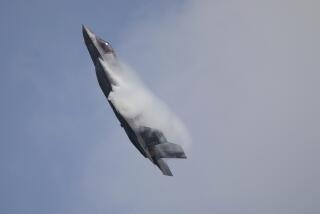The Tragedy of Flight 655 : Says Fliers May Not Tune In Emergency Channels : Ex-Iran Pilot Disputes Speed Report
- Share via
WASHINGTON — An Iran Air pilot who flew an Airbus on the same route as the ill-fated Flight 655 for more than two years said Monday that the plane shot down by a U.S. warship could not possibly have been flying at more than 500 miles an hour, as U.S. officials have said it was.
Mahmoud Vaziri, who left Iran last fall and now lives in Glendale, Calif., also said that pilots on the route of Flight 655 are so busy communicating with air traffic controllers that they sometimes do not tune their radios to the emergency channels over which U.S. Navy officials say they tried unsuccessfully to warn the doomed plane.
Indeed, Vaziri recalled an incident in which he himself learned his plane had been challenged by U.S. forces only because the radio call was overheard and relayed to him by an air traffic controller. Vaziri said he had not had a radio free at the time to tune to the emergency channel.
The jetliner’s speed as it was shot down is important because U.S. officials have said a plane flying as fast and as low as the one approaching the Vincennes seemed to pose a military threat. Adm. William J. Crowe Jr., chairman of the Joint Chiefs of Staff, said Sunday that the Iranian jetliner’s speed and descending flight path, combined with its failure to respond to the ship’s warnings, caused the ship’s commander to declare it hostile and shoot it down.
Vaziri said the Airbus A-300’s structural speed limit at altitudes up to 9,000 feet is 360 knots, or 414 miles an hour. The U.S. Navy says the plane was at about 9,000 feet when it was shot down, and Iran says it was even lower, at 7,500 feet.
“Normal Iran Air procedure, if you want to avoid turbulence, is 270 knots,” said the Iranian-born, American-trained pilot. A high-speed crossing of the gulf, he said, would probably not exceed 300 knots.
Normally a Slow Flight
Vaziri added that pilots on Flight 655 were urged to fly slowly between Bandar Abbas, on Iran’s southern coast, and Dubai, in the United Arab Emirates just across the gulf, so that passengers could be served refreshments. It was on this 150-mile leg, which ordinarily takes about 25 minutes, that Flight 655 was shot down.
Jane’s All the World’s Aircraft, an authoritative source, corroborates Vaziri on the Airbus’ speed. According to Jane’s, the A-300’s maximum speed below 26,000 feet, where air resistance is greater than at higher altitudes, is 345 knots.
Also, a U.S. Air Force pilot familiar with the Airbus said that the plane would have had to been in a steep dive to achieve 450 knots at that altitude. Crowe did not suggest the plane was diving toward the Vincennes.
Vaziri said air traffic over the southern end of the gulf is heavy, and pilots are in contact with a sequence of overlapping air traffic controllers. It is possible, Vaziri said, that the Iran Air pilot was not tuned to the emergency frequencies used by the Vincennes because of the need to switch radio channels numerous times during the brief flight to keep in touch with air traffic controllers.
During one of his own flights from Bandar Abbas to Jidda, Saudi Arabia, he said, the gulf’s prescribed communications procedures kept him from tuning one of his two radios into the international emergency channel, on which the captain of the Vincennes is said to have tried to warn Flight 655 away.
Alerted by Air Controllers
When he did not respond to a U.S. Navy query on that channel, Vaziri said he was alerted to the message by Bahraini air controllers with whom he was in contact. He quickly tuned in and was asked to identify himself and change course.
Vaziri said the pilot of the downed airliner, whom he identified as Amir Razvani, was trained in the United States. He called Razvani, about 34 years old, “pretty sharp--not at all erratic,” and added that Razvani spoke “pretty good English”--the language in which the warnings from the Vincennes were broadcast.
Crowe also said Sunday that the Vincennes did not pick up a signal from the jetliner’s transponder--a device used by all commercial airliners to broadcast a plane’s position and speed.
Vaziri said it was possible that the devices were not turned on or working properly. He said normal pre-flight checks include testing the transponders, but if they are not functioning properly on a short hop, he said, “it’s not a no-go item.”
Vaziri said it was possible that the pilot of the doomed jetliner would not have known of the skirmish under way on the gulf before taking off. “Iran Air is controlled by the civil aviation organization in Iran,” he said. “The military is a completely different thing. Information from one agency to another might take time.”
Asked if the pilot would have accepted a suicide mission or flown in a provocative way to draw U.S. fire, Vaziri responded quickly, “No way.”
“If you’re thinking about kamikaze stuff, this hasn’t even happened in the (Iranian) air force,” he said. “These guys, these commercial pilots, have all been trained over here (in the United States). Safety is above all. There’s no way they can make you do a (kamikaze) flight. They’re not idiots. (Political authorities) don’t have that kind of power.”
Times staff writer John M. Broder contributed to this article.
More to Read
Sign up for Essential California
The most important California stories and recommendations in your inbox every morning.
You may occasionally receive promotional content from the Los Angeles Times.













